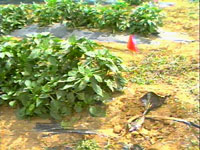Drought Has Some Kentucky Producers Looking at Potential of Irrigation
Drought Has Some Kentucky Producers Looking at Potential of Irrigation

Last year's drought and an increased interest in alternative farm enterprises have a growing number of Kentucky producers discussing the pros and cons of investing in irrigation equipment to insure a profitable harvest.
"Up to this point, irrigation in Kentucky has been limited," said Lloyd Murdock, an Extension Soils Specialist in the UK College of Agriculture based at the Research and Extension Center in Princeton, Ky.
Murdock recently polled county Extension agents in Kentucky to get at least an estimate of the type and amount of irrigation currently being used in the state.
Forty-six counties reported that only about one-to-two percent of the state's total field crop acreage is irrigated.
The key limiting factors include Kentucky's normally abundant rainfall and the geology and geography of the state. There are only a few small areas in extreme southwestern Kentucky and along rivers and some streams that have ground water in sufficient quantities to reliably provide enough water to irrigate large areas of field crops.
"Economic incentives are not that high for most field crops," noted Murdock. "Although one 10-year study did indicate that irrigated corn appears to be profitable."
But smaller acreage irrigation may see a substantial upswing in Kentucky as more producers start raising crops such as turf, tomatoes, and strawberries.
A 1989 survey indicated turf grass was already playing a big role in Kentucky's irrigation activities. Nine-thousand acres of golf courses, 3,000 acres of athletic turf, 500 acres of sod production and 115,000 acres of home lawns and commercial turf were being irrigated at that time.
As the tobacco base declines, the potential growth of fruit and vegetable operations could add additional acres to the list of irrigation activities.
"It is an essential element for vegetable crops with few exceptions," said Brent Rowell, Extension vegetables specialist in the UK College of agriculture. "No producer should consider a horticultural operation without it."
"Pumpkins might be one possible exception, but last year it would have been a problem even for that drought-tolerant crop," noted Rowell.
The start- up costs for a trickle or drip irrigation system will run around $600 to $800 per acre for the essentials such as water lines, filters, pumps, and fertilizer injectors.
After that the annual costs drop to about $300 per acre and Rowell said the expense is minimal for the protection it provides for the health of a potentially valuable crop.
A 10-year study on field crops in Kentucky also indicated that a field crop like corn could profit from the expenditures required to start up and maintain an irrigation system.
Center-pivot irrigation systems used for field crops cost between $300 and $400 per acre which includes the cost of drilling the well.
Additional information on irrigation equipment is available from county Extension agents for agriculture.
